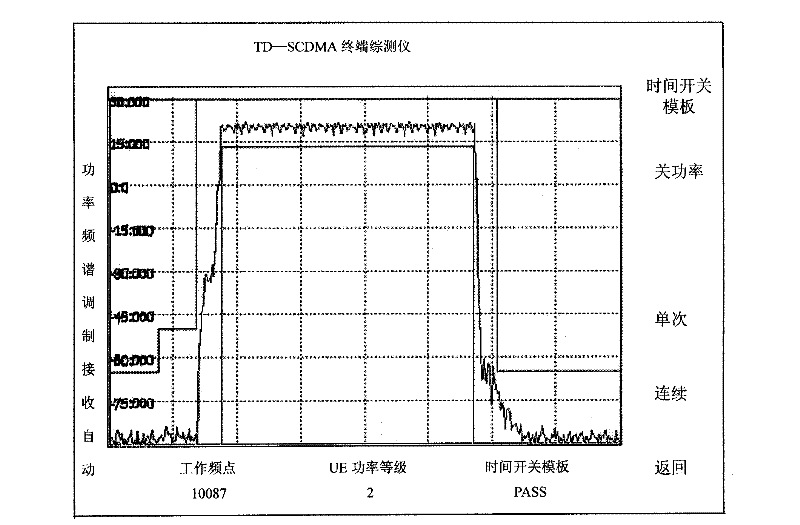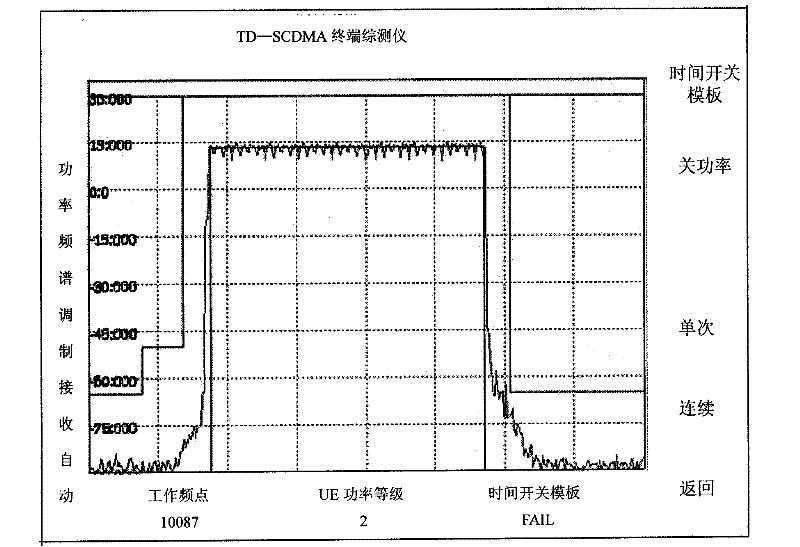Time switch template test method for TD-SCDMA terminal
A TD-SCDMA, time switch template technology, applied in energy-saving ICT, power management, sustainable buildings, etc., can solve problems such as difficulty in ensuring instrument reliability, unfavorable development and measurement of new TD-SCDMA terminals, and achieve long-term reliable maintenance. The effect of low requirements on repeatability and repeatability, and solving the requirements of high performance
- Summary
- Abstract
- Description
- Claims
- Application Information
AI Technical Summary
Problems solved by technology
Method used
Image
Examples
Embodiment 1
[0040] Embodiment 1: The sampling clock is 2.56MHz, and the steps are as follows:
[0041] (1) Set up the RMC reference measurement channel of 12.2kbps between the TD-SCDMA terminal test device and the TD-SCDMA terminal, then configure the TD-SCDMA terminal to enter the loopback test mode, and make the TD-SCDMA terminal transmit with a single code channel, Control the transmit power of the TD-SCDMA terminal to the maximum and complete the preparation for the test;
[0042] (2) Set the RF switch of the test equipment to the closed state;
[0043] (3) Control the TD-SCDMA terminal under test to send signals;
[0044] (4) Send a control signal to the A / D converter through the time delay device in the test equipment to ensure that the rising edge of the first sampling clock lags behind the RF switch control signal, and the A / D converter samples 2 point, and the sampling data is sent to the data processing device to calculate the signal power value of each sampling point accordin...
Embodiment 2
[0061] Embodiment 2: The sampling clock is 76.8MHz, and the steps are as follows:
[0062] (1) Set up the RMC reference measurement channel of 12.2kbps between the TD-SCDMA terminal test device and the TD-SCDMA terminal, then configure the TD-SCDMA terminal to enter the loopback test mode, and make the TD-SCDMA terminal transmit with a single code channel, Control the transmit power of the TD-SCDMA terminal to the maximum and complete the preparation for the test;
[0063] (2) Set the RF switch of the test equipment to the closed state;
[0064] (3) Control the TD-SCDMA terminal under test to send signals;
[0065] (4) Send a control signal to the A / D converter through the time delay device in the test equipment to ensure that the rising edge of the first sampling clock lags behind the RF switch control signal, and the A / D converter samples 60 times in one chip time points, and the sampling data is sent to the data processing device to calculate the signal power value of eac...
Embodiment 3
[0085] Embodiment 3 The sampling clock is 76.8MHz, and the steps are as follows:
[0086] (1) Set up the RMC reference measurement channel of 12.2kbps between the TD-SCDMA terminal test device and the TD-SCDMA terminal, then configure the TD-SCDMA terminal to enter the loopback test mode, and make the TD-SCDMA terminal transmit with a single code channel, Control the transmit power of the TD-SCDMA terminal to the maximum and complete the preparation for the test;
[0087] (2) Set the RF switch of the test equipment to the closed state;
[0088] (3) Control the TD-SCDMA terminal under test to send signals;
[0089] (4) Send a control signal to the A / D converter through the time delay device in the test equipment to ensure that the rising edge of the first sampling clock lags behind the RF switch control signal, and the A / D converter samples 60 times in one chip time points, and the sampling data is sent to the data processing device to calculate the signal power value of each...
PUM
 Login to View More
Login to View More Abstract
Description
Claims
Application Information
 Login to View More
Login to View More - R&D
- Intellectual Property
- Life Sciences
- Materials
- Tech Scout
- Unparalleled Data Quality
- Higher Quality Content
- 60% Fewer Hallucinations
Browse by: Latest US Patents, China's latest patents, Technical Efficacy Thesaurus, Application Domain, Technology Topic, Popular Technical Reports.
© 2025 PatSnap. All rights reserved.Legal|Privacy policy|Modern Slavery Act Transparency Statement|Sitemap|About US| Contact US: help@patsnap.com



